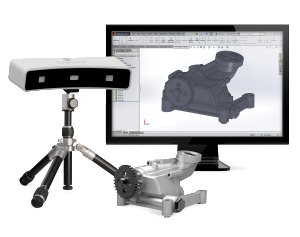What is 3D Scanning?
3D scanning is a non-contact, non-destructive way of capturing an accurate 3-dimensional digital copy of a physical object. Each scan produces millions of points to create a “point cloud” of data. A polygon surface can then be created from the points to create a “meshed surface.” 3D scanners excel at capturing free-form shapes quickly and accurately.
 3D scanning can help you:
3D scanning can help you:
- Create CAD Data
- Compare Parts
- Analyze the Competition
- Make Parts Fit Better
- Recreate Working, Broken, or Worn-out Parts
In order to:
- Shorten Production Cycles
- Increase Manufacturing Efficiency
- Improve Product Quality
- Cut Costs
- Get Products to Market Before the Competition
How 3D Scanning Works!
Scan Acquisition
By projecting a pattern of light onto an object and using two cameras at different angles to view the object, the “White or Blue Light Scanner” records several million “points” of data in 3-dimensional space. These points are then used to create polygons, making a “surface mesh.” Depending on the size of the object being scanned, either an automated rotating table will turn the object, stopping to take several different scans in 360 degrees, or the part/scanner can be manually turned to take the multiple scans.
Alignment and Combining
Once the scans have been captured, the software looks for similar shapes and geometry to align the multiple scans and combine them into a single object giving a 360 degree view. Overlapping/duplicate data can then be deleted to give you a complete meshed surface that can be viewed from all sides and angles.
Scan Applications
After the scan is complete and exported into a file format specified, it can be used in various software packages to produce things such as CAD models for reverse engineering, or color map deviation reports for product inspections.
